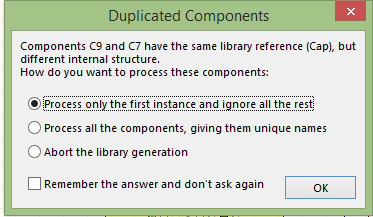Have you ever opened an Altium project only to discover that a Footprint or Schematic Library file is missing? Maybe your coworker forgot to commit the files to version control, or forgot to include them in the .zip file before leaving for vacation. If so, have no fear: you can recover the footprints easily and automatically.
Schematic Library
From the Schematic Editor, select Design -> Make Schematic Library.
Altium will convert each component on your schematic into a library component and will use the Library Reference parameter to name each component. However, if you use part parameters to store information like part numbers, vendor links, etc. (which you should be!), Altium will flag components with the same Library Reference but different parameters. An example of this is shown below. Two of the capacitors in my schematic use the same symbol but have different part number fields ("different internal structure" in Altium-speak).

There's no need to have several different capacitor (or inductor, resistor, etc) symbols in your symbol library - you just need to make sure you edit/verify the component parameters when you add the component to your schematic. But you do that anyway, right?
If you select "Process only the first instance and ignore the rest" and then click "Remember the answer and don't ask again", it will only create one schematic symbol per Library Reference.
When finished, the new symbol library will be added to your project and opened in Altium. By default, the library filename is set to whatever your project file is named.
Footprint Library
To generate a footprint library, go to your PCB Editor and select Design -> Make PCB Library. As before, Altium will create a new library component for each footprint in your design and then open the library for your perusal when complete.
Library Trimming
This functionality is useful in a few other cases as well. The main case is useful for handing off the finalized design to a client or manufacturer. In large embedded projects, it's common to make changes to the component selection in order to drive cost down, improve functionality, decrease power consumption, etc. As a result, there will be extra library components hanging around. Using the procedures described above, you can create libraries that contain only the parts in your design, rather than manually searching for and deleting the extras.
Happy PCB designing!
Learn more about DMC's embedded development and programming services.